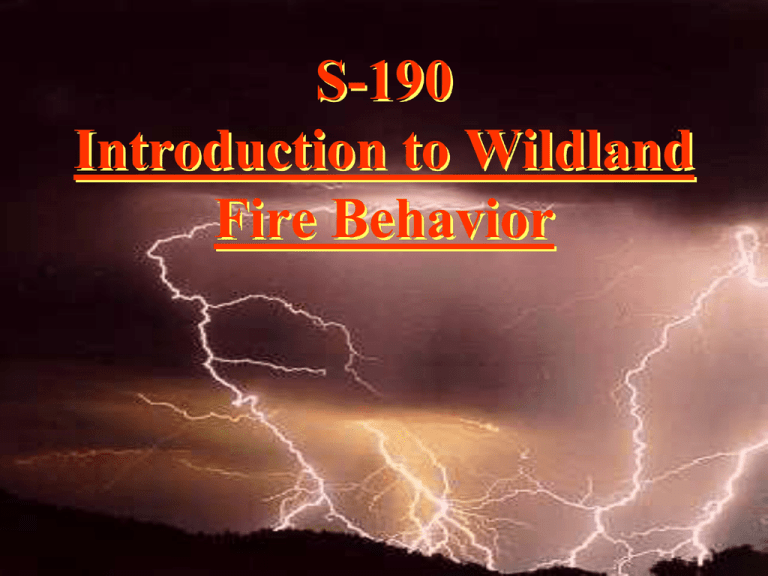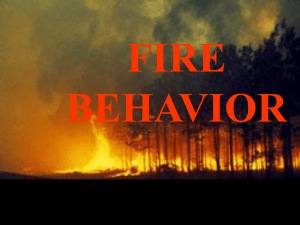Introduction to Wildland Fire Behavior
advertisement

S-190 Introduction to Wildland Fire Behavior Why we feel fire behavior training is critical COURSE OBJECTIVES Identify and discuss the three sides of the fire triangle. Identify the environmental factors of wildland fire behavior that affect the start and spread of wildland fire. Recognize situations that indicate problem or extreme wildland fire behavior. Unit 1 Objectives •1. Describe the fire triangle •2. Identify three methods of heat transfer •3. List the three env. elements affecting fire behavior. •4. List three fuel factors that affect wildland fire. •5. List 3 weather factors that affect fuel moisture •6. Describe how wind affects wildland fire spread •7. Describe the effect of slope on wildland fire spread •8. List 4 topographic factors that affect wildland fire behavior •9. Describe the dangerous conditions that can develop in a box canyon & steep narrow canyon •1. Describe the fire triangle Fuel HEAT SOURCES Lightning Cigarettes Powerlines Catalytic converters Small engine sparks Matches Magnifying glass FUELS •Grass •Shrubs •Trees •Houses •Propane tanks •Wood piles •Decks OXYGEN 2. Identify three methods of heat transfer Radiation Convection Conduction 3. List the three env. elements affecting fire behavior. Three Principal Environmental Elements Affecting Wildland Fire Behavior Fuels Weather Topography Group Exercise #1 Group 1: Identify the factors of fuels that affect fire behavior. Group 2: Identify the factors of weather that affect fire behavior. Group 3: Identify the factors of topography that affect fire behavior. video Fuel Type Fuel Moisture Size and Shape Fuel Loading Horizontal Continuity Vertical Arrangement Fuel Types Grass Brush Logging Slash Timber Fuel Moisture: The amount of water in a fuel expressed as a percentage of the oven-dry weight of that fuel Categories of Fuels Light fuels: Grass, Leaves, Shrubs Heavy fuels: Limbs, Logs, Stumps Light Fuels Heavy Fuels Fuel Loading: The quantity of fuels in an area. Generally expressed in Tons per Acre. Horizontal Continuity: Uniform vs Patchy Vertical Arrangement - Ground - Surface - Aerial Patchy Discontinuous Continuous Fuel Characteristics Vertical Arrangement Ground Fuels All combustible materials lying beneath the surface including deep duff, roots, rotten buried logs, and other organic material. Usually called a “PEAT FIRE” Surface Fuels All materials lying on or immediately above the ground including needles or leaves, grass, downed logs, stumps, large limbs and low shrubs. Aerial Fuels All green and dead materials located in the upper forest canopy including tree branches and crowns, snags, moss, and high shrubs. Temperature Wind - Increases supply of oxygen – Drives convective heat into adjacent fuels. – Influences spread direction and spotting. – Carries moist air away replacing it with drier air. – Dries Fuels. – Raises fuel moisture if the air contains moisture. Temperature Relative Humidity - As RH increases, fuel moisture increases Precipitation - Increases fuel moisture Temperature / RH Chart 24 hours Topography • Aspect - direction a slope faces • Slope - Steepness. • Position of Fire - Top, middle, or bottom of slope. • Shape of Country - Narrow canyons & box canyons. • Elevation - Relates to curing of fuels, precipitation, length of fire season, etc. Aspect Topography • Aspect - direction a slope faces • Slope - Steepness. • Position of Fire - Top, middle, or bottom of slope. • Shape of Country - Narrow canyons & box canyons. • Elevation - Relates to curing of fuels, precipitation, length of fire season, etc. Steep Slopes Cause Rapid Fire Spread Topography • Aspect - direction a slope faces • Slope - Steepness. • Position of Fire - Top, middle, or bottom of slope. • Shape of Country - Narrow canyons & box canyons. • Elevation - Relates to curing of fuels, precipitation, length of fire season, etc. Position of Fire on Slope Topography • Aspect - direction a slope faces • Slope - Steepness. • Position of Fire - Top, middle, or bottom of slope. • Shape of Country - Narrow canyons & box canyons. • Elevation - Relates to curing of fuels, precipitation, length of fire season, etc. Box Canyon & Chimney Effect Radiant Heat Across Narrow Canyon Spotting Across Narrow Canyon Mountains Cause Channeling of Wind Topography • Aspect - direction a slope faces • Slope - Steepness. • Position of Fire - Top, middle, or bottom of slope. • Shape of Country - Narrow canyons & box canyons. • Elevation - Relates to curing of fuels, precipitation, length of fire season, etc. Elevation Do Exercises pages 21-24 in workbook






